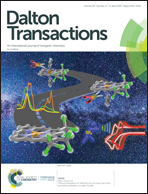Decomposition pathway of KAlH4 altered by the addition of Al2S3†
Abstract
Altering the decomposition pathway of potassium alanate, KAlH4, with aluminium sulfide, Al2S3, presents a new opportunity to release all of the hydrogen, increase the volumetric hydrogen capacity and avoid complications associated with the formation of KH and molten K. Decomposition of 6KAlH4–Al2S3 during heating under dynamic vacuum began at 185 °C, 65 °C lower than for pure KAlH4, and released 71% of the theoretical hydrogen content below 300 °C via several unknown compounds. The major hydrogen release event, centred at 276 °C, was associated with two new compounds indexed with monoclinic (a = 10.505, b = 7.492, c = 11.772 Å, β = 122.88°) and hexagonal (a = 10.079, c = 7.429 Å) unit cells, respectively. Unlike the 6NaAlH4–Al2S3 system, the 6KAlH4–Al2S3 system did not have M3AlH6 (M = alkali metal) as one of the intermediate decomposition products nor were the final products M2S and Al observed. Decomposition performed under hydrogen pressure initially followed a similar reaction pathway to that observed during heating under vacuum but resulted in partial melting of the sample between 300 and 350 °C. The measured enthalpy of hydrogen absorption (ΔHabs) was in the range −44.5 to −51.1 kJ mol−1 H2, which is favourable for moderate temperature hydrogen applications. Although, the hydrogen capacity decreases during consecutive H2 release and uptake cycles, the presence of excess amounts of aluminium allow for further optimisation of hydrogen storage properties.



 Please wait while we load your content...
Please wait while we load your content...